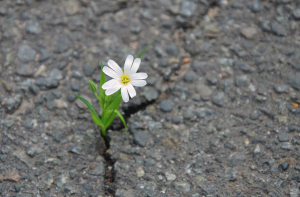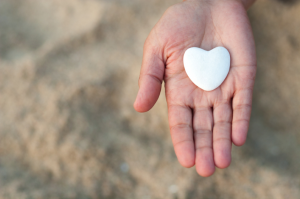She stood in the storm and when the wind did not blow her way, she adjusted her sails.
~ Elizabeth Edwards ~

During my lifetime, I have had friends who seem to always come out of any unfavorable situation smelling like a rose. You know the ones; they can go through multiple crisis or illnesses and somehow get back up swinging.
How do they do that?
Resilience. People who practice wholehearted living seem to share this trait across the board.
What is Resilience?
Resilience is one of those words which its original definition creates an analogous meaning as well. The etymology of the word resilience is as follows:
Latin verb resilire, meaning to “jump back” or “to recoil”
Merriam-Webster says:
the capability of a strained body to recover its size and shape after deformation caused especially by compressive stress
Then the analogous meaning:
an ability to recover from or adjust easily to misfortune or change
In short then, resilience is the ability to overcome adversity.
In The Gifts of Imperfection, Brené Brown’s research on resilient people points to five factors.
- They are resourceful and have good problem-solving skills.
- They are more likely to seek help.
- They hold the belief that they can do something that will help them to manage their feelings and to cope.
- They have social support available to them.
- They are connected with others, such as family or friends.
I am adding one of my own as a bonus number six … they have a sense of humor which works wonders.
If any or all these factors are lacking, even the smallest problems can become overwhelming. We can start to feel powerless, without hope, and in turn, resort to numbing behaviors.
What are Numbing Behaviors?
Let’s face it, as humans, we don’t like feeling uncomfortable. Our tendency is to automatically push down any discomfort as soon as we become aware of it. Once we get stressed, we either dismiss it, deny it, or try to numb it. In reality, discomfort is a signal and to be used as a pathway to information. And yet, we ignore it. Beneath the discomforting emotions, feelings can range from fear to rejection, criticism or imperfection. Those feelings are sometimes too big and too painful to acknowledge, so we opt for numbing.
There is a misconception that numbing belongs only to those who suffer with addictions. Brené Brown says numbing is far more insidious. We are numbing when we say things like we are “just blowing off steam” or “taking the edge off”.
“Taking the edge off” can come in many forms … food, alcohol, exercise, drugs, games, work, shopping, or even staying crazy busy. They all seem to be a widely used resource to avoid pain, discomfort, and feeling vulnerable. Unfortunately, it is not long lasting.
When we numb, we aren’t able to separate the stuff hurting us from the good stuff. It all gets numbed. If we want to numb feelings like disappointment, embarrassment or disgust … feelings such as joy, peace, and hope are also numbed.
The bad news is we are not able to numb the bad without numbing the good.
The good news is the opposite is also true. If we allow ourselves to feel the bad stuff, we can also feel the good. That means we must experience all those icky emotions we are trying so desperately to avoid.
Which is why developing resilience is critical.
How to Develop Resilience?
Like with all the other principles behind Wholehearted Living, developing resilience takes practice and hard work.
Name the Feeling: One such approach is being able to interpret the emotion and name exactly what you are feeling. Unfortunately when it comes to this skill, a lot of us are emotionally illiterate. On average most of us can only name three different emotions: happy, sad or angry. According to Brené Brown’s research, we must learn to recognize at least thirty core emotions to be able to achieve emotional literacy.
Feel the Feeling: Once we name the feeling, we must give ourselves time to FEEL the feeling; allow ourselves to reconnect to those emotions which may have been stuffed for a very long time. Find a safe alone space and dive deep, accepting that some of the feelings might not make sense at first. Write, dance, yell, cry … allow yourself to express that feeling in whatever way it needs to come out.
Get Support: Establishing a supportive nurturing social network can boost your emotional foothold during times of need. Start looking for those friends/people who have already learned the knack of resilience, hang around them, watching how they model this trait and glean that energy for yourself.
We might compare resilience to a river trip where we may encounter rapids, waterfalls, turns, surprises around the bend, obstacles (both seen and unseen), shallows and slow murky water. Times which are stressful and intense as well as quiet, slow and meditative times. The ways we navigate our journey vary depending on our experience, research, preplanning, knowledge, guides, and trusted companions. All these come in into play supporting us during our trip called life and helps see us through to our destination.
There is much more to cultivating a resilient spirit than what I have shared today. The topic of resiliency has other offshoots, some of which are spirituality (not religion) and developing hope. In my newly designed program (target release date January 1, 2019), we will be covering these components and more as we learn to become more resilient in Wholehearted Living.
Until then, the following prompts may help you hone in on what cultivating a resilient spirit means to you. If you feel like sharing, you can do so in the comment section below.
Journal Prompts:
- What does resilience mean to you?
- What numbing techniques do you use to hide or escape life?
- Off the top of your head, how many feeling words can you name?
My thanks to Brené Brown for her extensive research on the topic of what it means to be wholehearted via her book The Gifts of Imperfection. I am using her research as a guide to further my passion to help others discover their own authenticity and embrace their own third act of life.
Note: This is the third article of ten in describing Wholehearted Living. You can find the first article “Cultivate Authenticity” here … the second “Cultivate Self-Compassion” here.
 I love synchronicity even when it hits me right between the eyes. ::giggle::
I love synchronicity even when it hits me right between the eyes. ::giggle::

